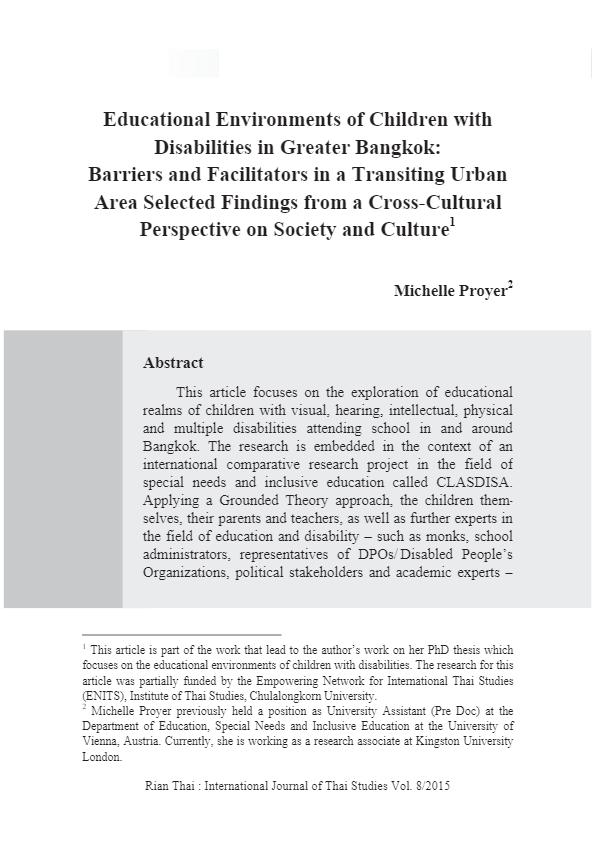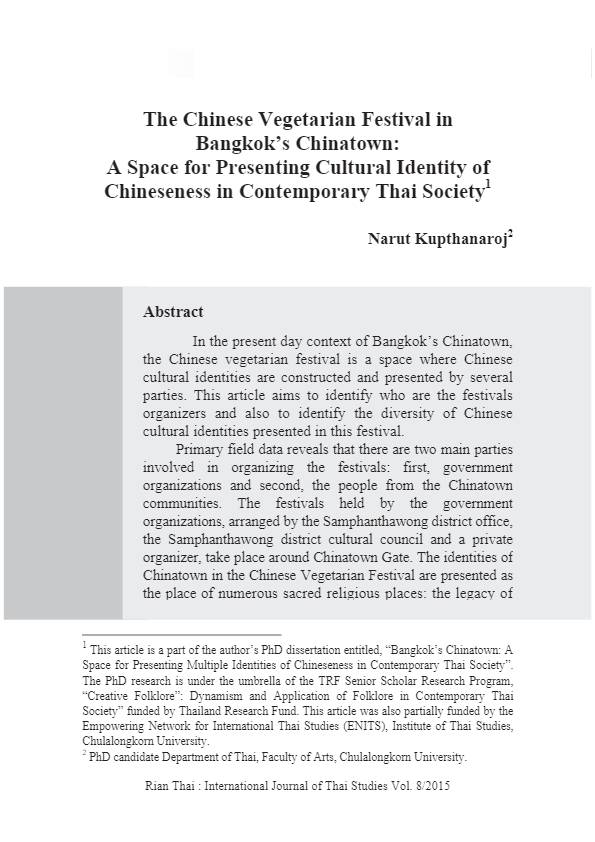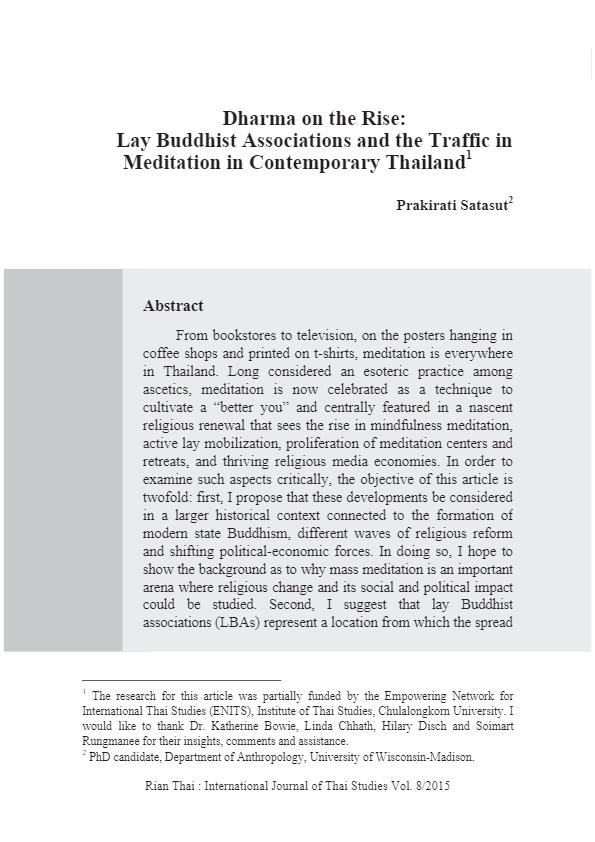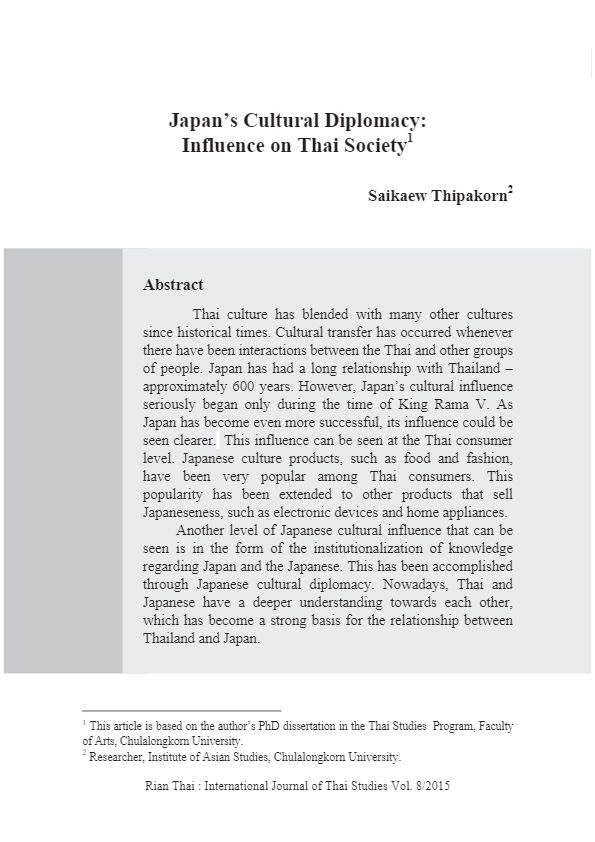Rian Thai - Volume 8/2015
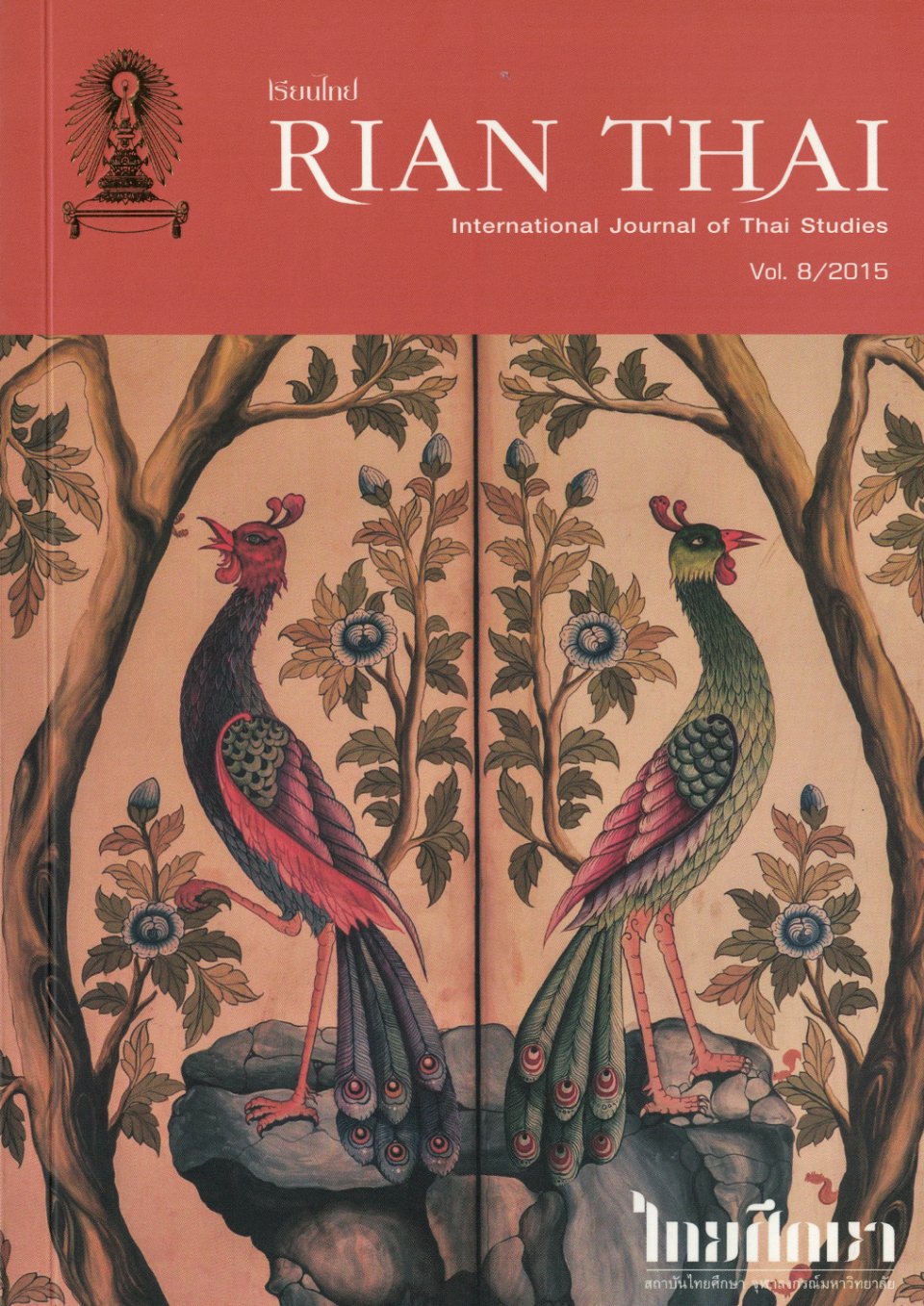
1) Akha Souvenir Sellers in Thailand's Urban Tourist Areas : Social, Economic, and Political Structures / Alexander Trupp
2) Thai 16mm Cinema : The Rise of a Popular Cinematic Culture in Thailand from 1945 to 1970 / Aliosha Herrera
3) The Map that Christmas Carols Made : A Case of Musical Appropriation and Application in a Karen Village / Benjamin Fairfield
4) "Snake Without Poison?" : (Re)Negotiating Hybrid Masculinities in Thailand / Daniel Whitehouse
5) Educational Environments of Children with Disabillities in Greater Bangkok : Barriers and Facilitators in a Transiting Urban Area Selected Findings from a Cross-Cultural Perspective on Society and Culture / Michelle Proyer
6) The Chinese Vegatarian Festival in Bangkok's Chinatown : A Space for Presenting Cultural Identity of Chineseness in Contemporary Thai Society / Narut Kupthanaroj
7) Dharma on the Rise : Lay Buddhist Associations and the Traffic in Meditation in Contemporary Thailand / Prakirati Satasut
8) Japan's Cultural Diplomacy : Influence on Thai Society / Saikaew Thipakorn
9) The Bodhisattva Avalokitesvara in Thai-Malay Peninsula and Western Indonesia : The Early Development of Buddhist Imagery in Insular Southeast Asia / Sofia Sundstrom
10) Phra Upakhut Midnight Almsgiving Ritual : The Reproduction of a Northern Thai Ritual in Central Thailand / Watcharaporn Distapan
Akha Souvenir Sellers in Thailand's Urban Tourist Areas : Social, Economic, and Political Structures
Alexander Trupp
Abstract
In recent decades one can observe an increasing percentage of highland ethnic minorities living in Thailand’s capital city Bangkok, as well as in medium-sized cities and tourist centres in the North or in the South of the country. This article deals with the ethnic minority group of Akha, and specifically Akha women, who have been migrating into Thailand’s urban and tourist areas in order to sell handicrafts and souvenirs. They have become micro-entrepreneurs or selfemployed street merchants. The core interest of this contribution lies in analyzing and understanding structural conditions that shape the opportunity structures and economic action of Akha own-account workers in Thailand’s urban tourist areas. This includes an analysis of the Akha vendors’ social networks as well as their embeddedness in economic and political structures in the field of urban ethnic businesses.
(Published in Rian Thai: International Journal of Thai Studies, Volume 8/2015, Page 1-26)
Full Text : Download
Thai 16mm Cinema : The Rise of a Popular Cinematic Culture in Thailand from 1945 to 1970
Aliosha Herrera
Abstract
In the aftermath of the Second World War, the introduction of silent 16mm celluloid stock gave rise to a very popular form of cinematic culture in Thailand. This local film production developed in close relation with its largely rural audience and ended at the beginning of the 1970s, when the practice of shooting films in 35mm Cinemascope regained momentum. This research focuses on a non-inventoried archival collection of Thai 16mm movies and retraces their historical context of emergence. The research explores how these low-budget melodramatic fictions, initially interpreted by professional dubbers in live performances, can be characterised as attractions incorporated in the paradigm of an oral theatrical experience derived from older practices of folk drama. The main question addressed is to what extent the wide circulation of 16mm movies might have provided a margin for the popular Thai cinema of that time to become a significant horizon of cultural expression, at the confluence of former local narrative traditions and Cold War modernity.
(Published in Rian Thai: International Journal of Thai Studies, Volume 8/2015, Page 27-61)
Full Text : Download
The Map that Christmas Carols Made : A Case of Musical Appropriation and Application in a Karen Village
Benjamin Fairfield
Abstract
Described by Charles Keyes as the greatest success case of Christian conversion in Southeast Asia, the Karen people’s experience with Protestant Christianity offers a unique case study on missionary work, indigenous appropriation, and the role of music in marking out the ‘we-self’ community from the ‘other.’ This article highlights Karen agency in history, religion, and music in directing a future-oriented, indigenized Christian faith and pairing ethnic destiny with Christian networking to preserve an indigenous people on specific, localized terms. Myths foretelling of the “white brother” with a “golden book,” traditional tha poetry, and Western church music were and are reshaped by white Baptist missionaries and Karen theologians alike in a two-way negotiation. While scholars in the past wrote off Karen Christian musical expression as abandonment of tradition, I argue that both the act of appropriation and the results of domesticating Western religious music challenge essentialist conceptions of “foreign” and “authentic” in Karen culture. This article will examine general religious historical contexts before launching into an analysis of one specific Karen community in Thailand that enacts these ideas in musical practice, appropriating Christmas carols as a mediating technology and setting ethnic boundaries through aural mapping. In order to examine these trends, I condense historic and contemporary ethnographic narratives, apply Thongchai Winichakul’s theories on mapping as a mediating technology, and draw upon musical and ethnographic data from my own field research in Chiang Mai province.
(Published in Rian Thai: International Journal of Thai Studies, Volume 8/2015, Page 63-85)
Full Text : Download
"Snake Without Poison?" : (Re)Negotiating Hybrid Masculinities in Thailand
Daniel Whitehouse
Abstract
A handful of Thai gender studies academics have noted that the field’s failure to develop a satisfactory episteme of contemporary masculinities is the result of a dominant theoretical approach which has favoured cultural exceptionalism whilst eschewing the frameworks developed in Western academia. This article maintains that this approach – which I argue had been a mainstay of the Thai anthropology of the fifties and sixties and, later, during the intensive research effort of the 1990s AIDS crisis – has resulted in a currently stagnant academic construction of the Thai male as a series of crude stereotypes whose behaviour is rooted in ‘traditional’ cultural values and beliefs.
Drawing on six months ethnographic fieldwork performed in the northern town of Nan during 2012, I argue that Thai gender studies must move beyond the explanatory models of ‘traditional’ Buddhist values and begin to see Thai masculinity as an intensely hybrid and internally contested discourse, the meanings of which are constantly in flux. By analysing the discursive strategies of male members of the Nan municipal fitness centre, I note how individuals are able to reject, appropriate and (re)negotiate dominant idioms and discursive formations of masculinity in a bid to construct their own pragmatic interpretations of legitimate masculine subjectivities. In doing so, these men become implicated in a poly-vocal and power-laden discourse which constantly re-defines ‘Thai masculinity’, thereby interrupting its perceived fixity. Drawing from the works of Foucault and Bhabha, this article will introduce the term ‘hybrid masculinities’ and consider the potential benefits of its application to the established theoretical tools currently employed in the study of gender and identity in contemporary Thai culture.
(Published in Rian Thai: International Journal of Thai Studies, Volume 8/2015, Page 87-122)
Full Text : Download
Educational Environments of Children with Disabillities in Greater Bangkok : Barriers and Facilitators in a Transiting Urban Area Selected Findings from a Cross-Cultural Perspective on Society and Culture
Michelle Proyer
Abstract
This article focuses on the exploration of educational realms of children with visual, hearing, intellectual, physical and multiple disabilities attending school in and around Bangkok. The research is embedded in the context of an international comparative research project in the field of special needs and inclusive education called CLASDISA. Applying a Grounded Theory approach, the children themselves, their parents and teachers, as well as further experts in the field of education and disability – such as monks, school administrators, representatives of DPOs/ Disabled People’s Organizations, political stakeholders and academic experts – were invited to share their experiences regarding education in the course of interviews and focus group discussions. Special instruments had been prepared to investigate perspectives of those children who were unable or preferred not to speak. Sign Language interpreters were provided and picture cards made available for the children to express their opinion non-verbally or in an alternative way. This article focuses specifically on qualitative data that was collected during four phases of field research in the course of almost three years. All steps were coordinated and conducted in collaboration with a local Thai research team. This was to guarantee language/culture-related competency and sensitivity at all stages of the research process, as well as a broad perspective on factors that facilitate or restrict education. The research focuses on how these factors are influenced or shaped by cultural or societal conditions and considers how the latter might differ from other countries or places in Thailand. Currently, data is being analyzed employing the qualitative data analysis (QDA) tool ATLAS.ti. This article focuses on the description of the study design, its international contex-tualization and the discussion of first preliminary findings.
(Published in Rian Thai: International Journal of Thai Studies, Volume 8/2015, Page 123-145)
Full Text : Download
The Chinese Vegatarian Festival in Bangkok's Chinatown : A Space for Presenting Cultural Identity of Chineseness in Contemporary Thai Society
Narut Kupthanaroj
Abstract
In the present day context of Bangkok’s Chinatown, the Chinese vegetarian festival is a space where Chinese cultural identities are constructed and presented by several parties. This article aims to identify who are the festivals organizers and also to identify the diversity of Chinese cultural identities presented in this festival.
Primary field data reveals that there are two main parties involved in organizing the festivals: first, government organizations and second, the people from the Chinatown communities. The festivals held by the government organizations, arranged by the Samphanthawong district office, the Samphanthawong district cultural council and a private organizer, take place around Chinatown Gate. The identities of Chinatown in the Chinese Vegetarian Festival are presented as the place of numerous sacred religious places: the legacy of faith for the vegetarian festival, the place for Chinese Thai people who have been living under royal benevolence, and the resource for the great taste of food. The objectives of the event are to promote tourism, to conserve Chinese culture, to build up reputation for local politicians and local businessman, and to increase the profit and market share for the sponsor’s products.
On the other hand, the festival held by the Chinatown communities, which significantly present Chinese Thai’s identities, is the vegetarian festival at Chow Sue Kong Shrine, Talad Noi area. What makes this event different from the others is that they have an outside organization, Arsomsilpa Institute, to help arranged the event. The important identities presented in this festival are local history, Chinese Thai and Yaowarat lifestyle, and the delight of Chinese vegetarian festival in the Talad Noi area. The festival’s purposes are to form and present Talad Noi’s identities to the public, to save the site from overdevelopment, and to encourage the local people to value their community.
(Published in Rian Thai: International Journal of Thai Studies, Volume 8/2015, Page 147-172)
Full Text : Download
Dharma on the Rise : Lay Buddhist Associations and the Traffic in Meditation in Contemporary Thailand
Prakirati Satasut
Abstract
From bookstores to television, on the posters hanging in coffee shops and printed on t-shirts, meditation is everywhere in Thailand. Long considered an esoteric practice among ascetics, meditation is now celebrated as a technique to cultivate a “better you” and centrally featured in a nascent religious renewal that sees the rise in mindfulness meditation, active lay mobilization, proliferation of meditation centers and retreats, and thriving religious media economies. In order to examine such aspects critically, the objective of this article is twofold: first, I propose that these developments be considered in a larger historical context connected to the formation of modern state Buddhism, different waves of religious reform and shifting political-economic forces. In doing so, I hope to show the background as to why mass meditation is an important arena where religious change and its social and political impact could be studied. Second, I suggest that lay Buddhist associations (LBAs) represent a location from which the spread of meditation can be concretely explored, not the least due to their role in organizing religious learning and formulating innovative cultural practices aimed at cultivating ethical subjectivity of Buddhist masses. The profiles of two prominent institutions, Young Buddhist Association of Thailand and Buddhadasa Indapanno Archives, are presented to illustrate the significance that LBAs have in the current meditation trafficking. Studying these sites, I argue, presents a unique opportunity to see mass meditation from a standpoint that has by far received little scholarly attention.
(Published in Rian Thai: International Journal of Thai Studies, Volume 8/2015, Page 173-207)
Full Text : Download
Japan's Cultural Diplomacy : Influence on Thai Society
Saikaew Thipakorn
Abstract
Thai culture has blended with many other cultures since historical times. Cultural transfer has occurred whenever there have been interactions between the Thai and other groups of people. Japan has had a long relationship with Thailand – approximately 600 years. However, Japan’s cultural influence seriously began only during the time of King Rama V. As Japan has become even more successful, its influence could be seen clearer. This influence can be seen at the Thai consumer level. Japanese culture products, such as food and fashion, have been very popular among Thai consumers. This popularity has been extended to other products that sell Japaneseness, such as electronic devices and home appliances.
Another level of Japanese cultural influence that can be seen is in the form of the institutionalization of knowledge regarding Japan and the Japanese. This has been accomplished through Japanese cultural diplomacy. Nowadays, Thai and Japanese have a deeper understanding towards each other, which has become a strong basis for the relationship between Thailand and Japan.
(Published in Rian Thai: International Journal of Thai Studies, Volume 8/2015, Page 209-226)
Full Text : Download
The Bodhisattva Avalokitesvara in Thai-Malay Peninsula and Western Indonesia : The Early Development of Buddhist Imagery in Insular Southeast Asia
Sofia Sundstrom
Abstract
Various scholars, including Nadine Dalsheimer and Pierre-Yves Manguin, have discussed the possible presence of a pan-Southeast Asian influence that took place before a local artistic language developed in relation to Hindu and Buddhist art. The focus of these various scholars have primarily been on mainland Southeast Asia or on Visnu images, thus early images of the Bodhisattva Avalokitesvara have not met with the same scrutiny.
The Thai-Malay peninsula, as well as western Indonesia, has yielded a number of Avalokitevara images in stone, metal and clay. The earliest form of Avalokitevara in Southeast Asia is a standing form that is spread along the coast in the western part of Southeast Asia (Thai-Malay Peninsula and Sumatra), with the Thai Isthmus playing a crucial role in the spread of an iconographic type. This article examines whether there is a second group of early Avalokitesvara images that connects peninsular Thailand with the Dvaravati region, as well as with Java. Through my work I hope to determine whether there are any iconographic or stylistic features that are specific to early Avalokitesvara images from peninsular Thailand. Dr Chutiwongs and Dr Chirapravati have both touched on this subject in their respective PhD dissertations; however, by comparing the images found in peninsular Thailand to those from the rest of insular Southeast Asia, I hope to be able to establish a time-line for how the production of Avalokitesvara images developed in this area.
(Published in Rian Thai: International Journal of Thai Studies, Volume 8/2015, Page 227-256)
Full Text : Download
Phra Upakhut Midnight Almsgiving Ritual : The Reproduction of a Northern Thai Ritual in Central Thailand
Watcharaporn Distapan
Abstract
Phra Upakhut midnight almsgiving ritual or the almsgiving ritual on full-moon Wednesday is a persistent tradition in northern Thailand. This ritual is practiced only on full-moon Wednesday because northern Thais believe that Phra Upakhut, a disciple of the Buddha who has magical powers, will leave the bottom of the sea where he resides and come to the world to collect his alms only on that day. There are stories about people who give alms to Phra Upakhut on the special day and are blessed with wealth in return. Therefore, giving alms to the monks on full-moon Wednesday has become a popular ritual among northern Thais.
Since 2009, Phra Upakhut midnight almsgiving ritual has also been found in other areas outside the north, such as Prachuap Khiri Khan Province and Nonthaburi Province in central Thailand. This article will then focus on studying the reproduction of this ritual in central Thailand, examining how patterns and details of the ritual vary from the ones originally practiced in the north. When this ritual is reproduced in the new areas, some patterns and details are changed in accordance with central Thai culture. Consequently, Phra Upakhut midnight almsgiving ritual in Prachuap Khiri Khan and Nonthaburi is different from the original ritual practiced in the north. For example, in Prachuap Khiri Khan, the time of the ritual is changed from midnight to early morning. Also, the ordination of novices and their roles in alms collection are added to the ritual when it is held in Nonthaburi.
The phenomenon of the reproduction of Phra Upakhut midnight almsgiving ritual in central Thailand indicates how the socio-cultural context of central Thailand determines the kinds of change in the borrowed northern Thai ritual. In addition, this article will discuss how the contemporary context of tourism and capitalism affects Thai folklore and tradition in the midst of changing Thai society.
(Published in Rian Thai: International Journal of Thai Studies, Volume 8/2015, Page 258-283)
Full Text : Download
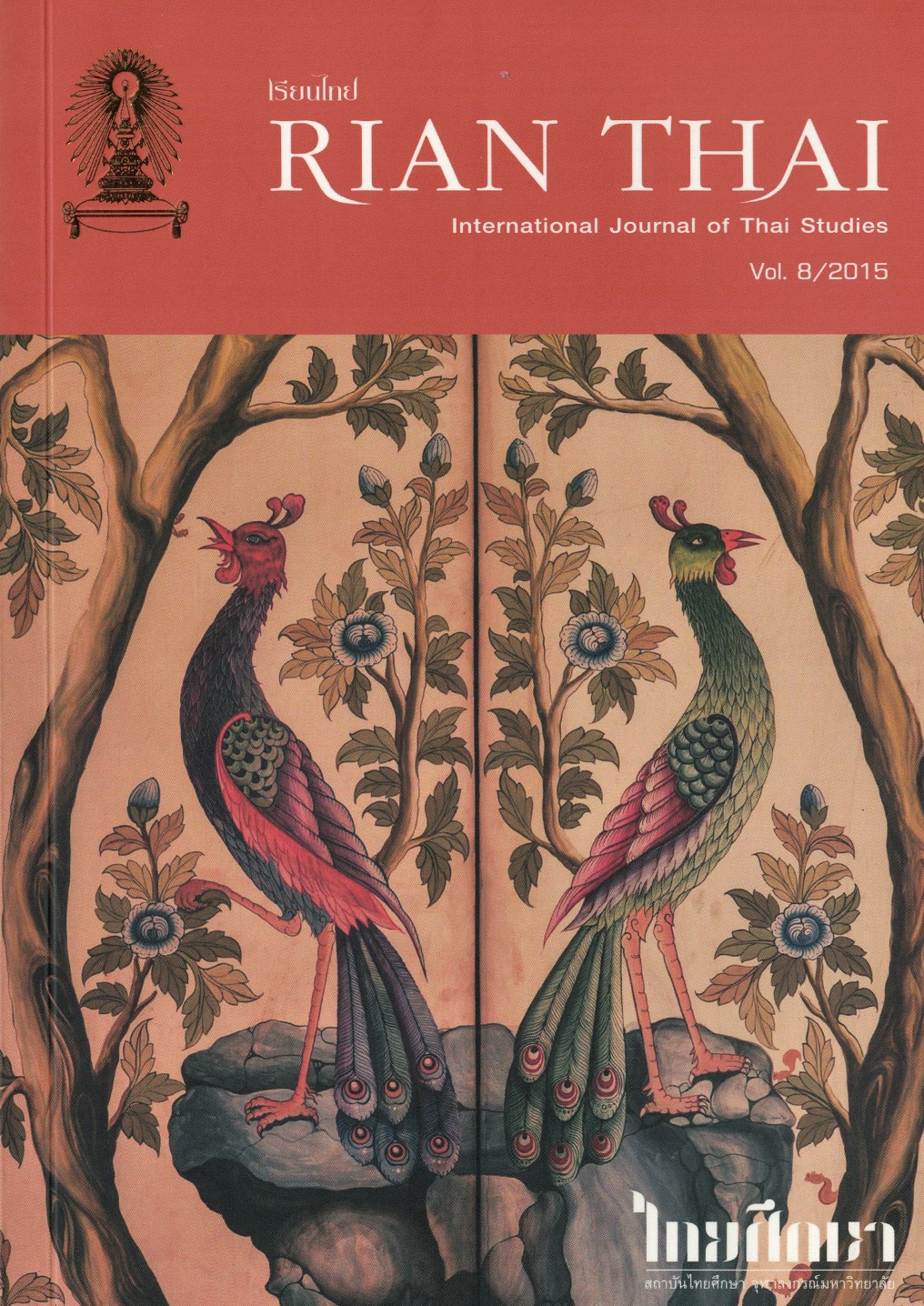
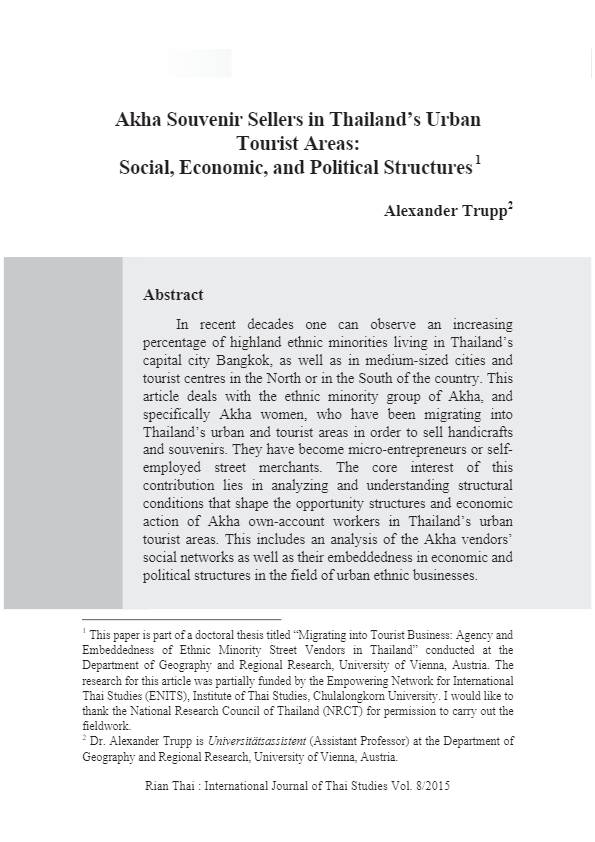


Negotiating%20Hybrid%20Masculinities%20in%20Thailand.pdf.jpg?alt=media&token=58cc020e-fbea-4cd8-be16-64587c5228ac)
